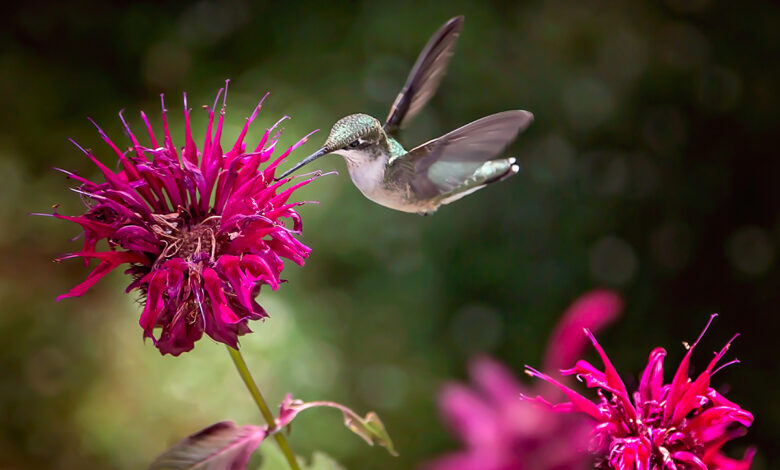Follow the hummingbirds to a culinary herbal delight

One of the herbs the hummingbirds seem to enjoy the most in my garden are the varieties of Monarda (bergamot or bee balm) that I grow. From an herbal perspective, there are two varieties that I use the most: my favorite is the scarlet bergamot (Monarda didyma), but I also use wild bergamot (Monarda fistulosa). The flower is perfect for the hummers to enjoy, because they are tubular and so they, butterflies, and bumble bees are its primary pollinators. If you cut the flowers back immediately after flowering, you can get a second flush of flowers for use and enjoyment!
Monarda fistulosa is often referred to by members of the Oneida Nation as “No. 6” and used for an upper respiratory tea. It is also known as “Oswego Tea” because the Native Americans who originally lived in the Oswego region of New York used it to make a tea to treat mouth and throat infections. There is a scientific explanation to what Native people have always known: these plants are strong antiseptics because they have a high thymol content, which makes it useful for colds, flu, upper respiratory problems, whooping cough and topically for skin problems and wounds. As a mouthwash, a strong infusion can relieve sore throats, toothaches and mouth sores. The leaves can also be used to make a steam to help clear the sinuses. Soldiers historically chewed the leaves and used them topically under bandages to slow bleeding when on the battlefield. Some references indicate that the plant got the common name of “bee balm” because an extract from the plant was used to soothe and heal injuries, especially bee stings.
One of my favorite ways to prepare and preserve Monarda for cold and flu season is in culinary items that I can use as needed, or when I want to take advantage of the fabulous flavor in my cooking. Herbal honeys, vinegars, oxymels and culinary salts are some of the ways I preserve Monarda. It is prime time right now to be harvesting and preparing these culinary delights. You can also make pesto using the leaves and flower instead of, or in addition to, basil or other pesto-friendly greens. The leaves can be chopped finely and used anywhere you might use oregano or thyme. I particularly like the leaves on roasted vegetables, in sauces that I might use with tofu and vegetables, or on fish. You can also dry the leaves and flowers in salt—alone or in combination with other herbs—and use the salts in your cooking. These are wonderful in egg dishes or anywhere that you might like a citrusy yet somewhat “zingy” flavor.
Kids can be introduced to vinegars through the beauty of this plant. Chop Monarda leaves and flowers (about 4 cups) and put in a wide-mouth quart jar, then cover with 3 cups of white balsamic vinegar. Cap, shake gently, and put the jar where it will receive some indirect sunlight. Shake every day or so, and kids will find the vinegar changing color with time. After 3-4 weeks, strain and pour into a dark glass bottle to protect from light. Use your vinegar in salad dressings, drizzle over roasted vegetables or anywhere you use vinegar. Find more recipes for kids here: https://theherbalacademy.com/herbal-honey-recipes-for-kids/.
Oh! And let’s put one piece of false information to rest. This delightful plant is not the basis for the flavor of my favorite black tea, Earl Grey. This flavor comes from bergamot oil, which is harvested from the citrus fruit known as bergamot, thought to be a natural hybrid between sour orange and either a lemon or citron. It is believed that Monarda gained the name “bergamot” because its aroma and flavor was similar to that produced by this fruit. n
T. Heather Herdman, RN, PhD, FNI, FAAN is a nurse, clinical herbalist and aromatherapist, who believes that a combination of traditional (herbalism, for example) and allopathic (Western) health care practices provide the strongest possibilities for health and well-being. She is the owner of Sweet Willow Wellness and Sweet Willow Herbal Co-Op (De Pere).
She holds nursing master’s and doctoral degrees from Boston College, and an undergraduate degree from University of South Carolina. She has authored numerous publications in peer reviewed journals, and her academic interests include clinical reasoning, spirituality, cultural health care practices, and integrative health care. Heather provides clinical herbal consults and custom blends herbal products for clients.
“Herbal honeys, vinegars, oxymels and culinary salts are some of the ways I preserve Monarda. It is prime time right now to be harvesting and preparing these culinary delights.”




